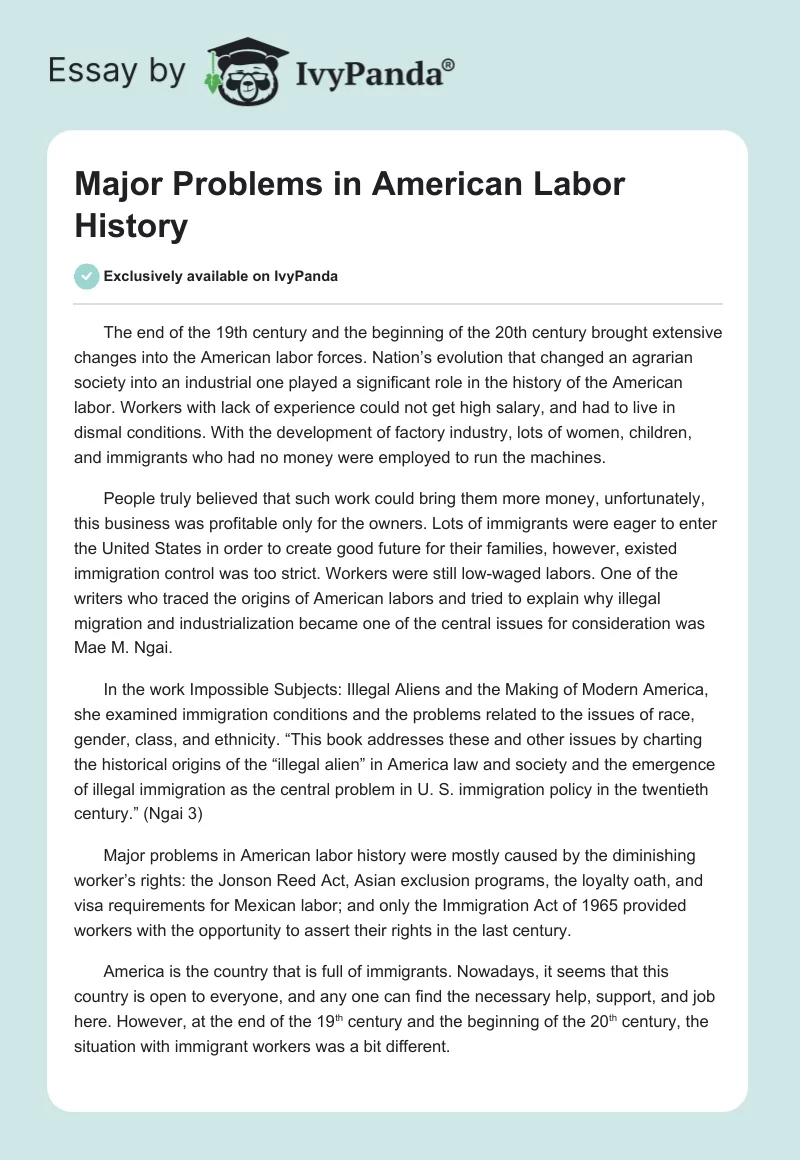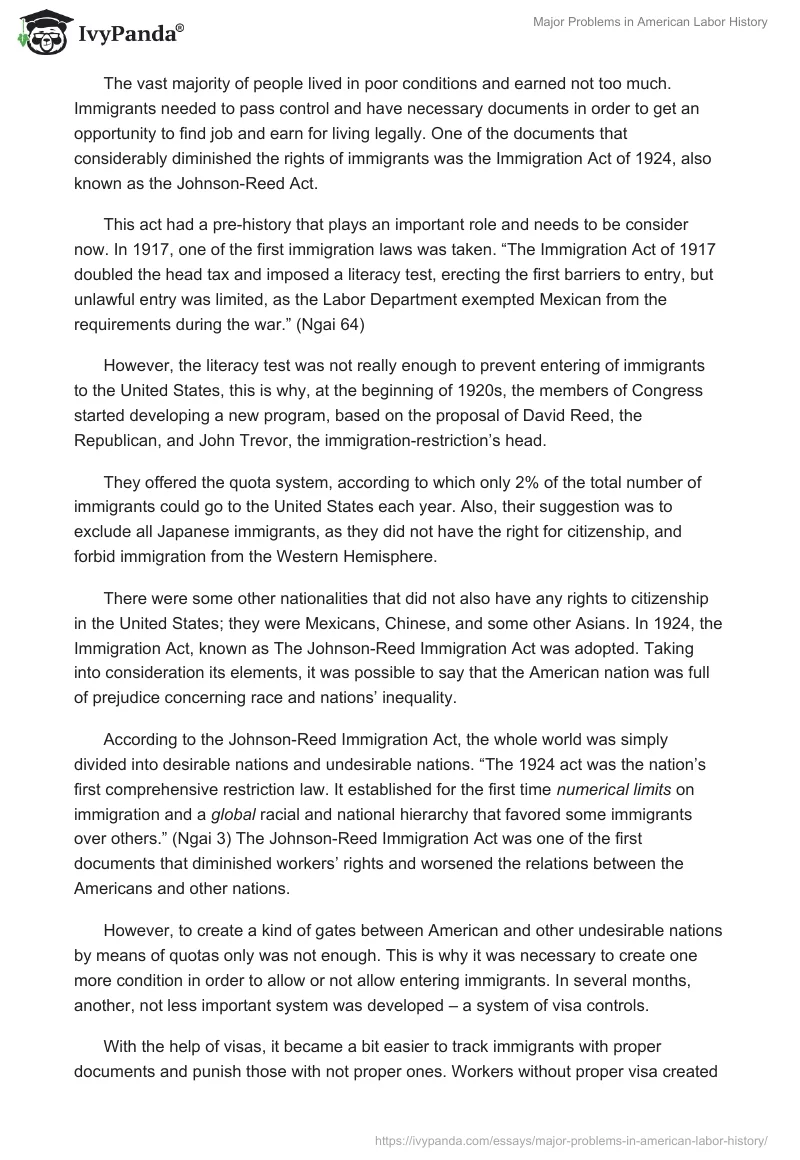The end of the 19th century and the beginning of the 20th century brought extensive changes into the American labor forces. Nation’s evolution that changed an agrarian society into an industrial one played a significant role in the history of the American labor. Workers with lack of experience could not get high salary, and had to live in dismal conditions. With the development of factory industry, lots of women, children, and immigrants who had no money were employed to run the machines.
People truly believed that such work could bring them more money, unfortunately, this business was profitable only for the owners. Lots of immigrants were eager to enter the United States in order to create good future for their families, however, existed immigration control was too strict. Workers were still low-waged labors. One of the writers who traced the origins of American labors and tried to explain why illegal migration and industrialization became one of the central issues for consideration was Mae M. Ngai.
In the work Impossible Subjects: Illegal Aliens and the Making of Modern America, she examined immigration conditions and the problems related to the issues of race, gender, class, and ethnicity. “This book addresses these and other issues by charting the historical origins of the “illegal alien” in America law and society and the emergence of illegal immigration as the central problem in U. S. immigration policy in the twentieth century.” (Ngai 3)
Major problems in American labor history were mostly caused by the diminishing worker’s rights: the Jonson Reed Act, Asian exclusion programs, the loyalty oath, and visa requirements for Mexican labor; and only the Immigration Act of 1965 provided workers with the opportunity to assert their rights in the last century.
America is the country that is full of immigrants. Nowadays, it seems that this country is open to everyone, and any one can find the necessary help, support, and job here. However, at the end of the 19th century and the beginning of the 20th century, the situation with immigrant workers was a bit different.
The vast majority of people lived in poor conditions and earned not too much. Immigrants needed to pass control and have necessary documents in order to get an opportunity to find job and earn for living legally. One of the documents that considerably diminished the rights of immigrants was the Immigration Act of 1924, also known as the Johnson-Reed Act.
This act had a pre-history that plays an important role and needs to be consider now. In 1917, one of the first immigration laws was taken. “The Immigration Act of 1917 doubled the head tax and imposed a literacy test, erecting the first barriers to entry, but unlawful entry was limited, as the Labor Department exempted Mexican from the requirements during the war.” (Ngai 64)
However, the literacy test was not really enough to prevent entering of immigrants to the United States, this is why, at the beginning of 1920s, the members of Congress started developing a new program, based on the proposal of David Reed, the Republican, and John Trevor, the immigration-restriction’s head.
They offered the quota system, according to which only 2% of the total number of immigrants could go to the United States each year. Also, their suggestion was to exclude all Japanese immigrants, as they did not have the right for citizenship, and forbid immigration from the Western Hemisphere.
There were some other nationalities that did not also have any rights to citizenship in the United States; they were Mexicans, Chinese, and some other Asians. In 1924, the Immigration Act, known as The Johnson-Reed Immigration Act was adopted. Taking into consideration its elements, it was possible to say that the American nation was full of prejudice concerning race and nations’ inequality.
According to the Johnson-Reed Immigration Act, the whole world was simply divided into desirable nations and undesirable nations. “The 1924 act was the nation’s first comprehensive restriction law. It established for the first time numerical limits on immigration and a global racial and national hierarchy that favored some immigrants over others.” (Ngai 3) The Johnson-Reed Immigration Act was one of the first documents that diminished workers’ rights and worsened the relations between the Americans and other nations.
However, to create a kind of gates between American and other undesirable nations by means of quotas only was not enough. This is why it was necessary to create one more condition in order to allow or not allow entering immigrants. In several months, another, not less important system was developed – a system of visa controls.
With the help of visas, it became a bit easier to track immigrants with proper documents and punish those with not proper ones. Workers without proper visa created a separate class of people who sooner will be deported. Because of such importance of having proper visa, one more problem appeared in the West and Southwest. It was the Mexican race problem, specially, in Texas. The idea of visa requirements for Mexican workers was one more factor that also diminished the rights of immigrant workers in the United States.
Mexican workers were one of the cheapest labors in America. American government did not want to lose them, however, it was impossible to make Mexican immigration legal. “Mexican entered the United States through a variety of means that were illegal but compromised irregular, unstable categories of lawful admission, making it more difficult to distinguish between those who were lawfully in the country and those who were not.” (Ngai 70)
Some Mexicans still could legally enter the United States; they were temporary visitors who came to the country for one agricultural season to earn some money, and returned to Mexico in six months or in a year. Under such conditions, the Immigration Service did not pay attention to the information in passport and visas of immigrants from Canada, Cuba, and Mexico, these immigrants should pay head tax, and leave the country in time.
In case the immigrant did not leave the country, this presence considered to be illegal. In comparison to Asian and European workers, Mexican ones were eligible to citizenship. “The relationship between American employers and Mexican workers has been much more symbiotic that most people generally have wished to acknowledge.” (Gutiérrez xii)
The rights of other immigrants, Asian workers in particular, were diminished a lot. According to the Immigration Act of 1924 consisting of the National Origins Act and the Asian Exclusion Act, immigration of Asians was excluded, and those who wanted to enter the United States had to take loyalty oaths. The Act was a bright example of race legislation in America. That Act restricted freedom of people according to their race and nation identity.
Despite of the restrictions pointed out in the Johnson-Reed Act, lots of Asians still continued to immigrate to the USA. Men had to leave their families in order to earn money and help their wives. Sometimes, immigrants got opportunities to stay in the United States to continue working.
Such immigration was illegal, however, the idea that the United States offered more opportunities to workers than their native country became a significant factor. Asians had to take the loyalty oaths in order to get a chance and leave their native country to work for Americans. For some Asians, it was too humiliating. This is why not every Asian was eager to take an oath in order just to get an opportunity to earn for living.
The result was “mass repatriation and for revoking the citizenship of all Japanese Americans who answered “no” to the loyalty oath.” (Ngai 187) Asian exclusion plays a significant role for further development of the events: general strikes, scuffles, and crowds of people made American security nervous and dissatisfied. It became more difficult to suppress discontents and control the situation. The loss of documents and mess with quotas oppress control.
Of course, such situation and diminishing of immigrants’ rights grounding on their race and nationality caused lots of misunderstandings, discontents, and civil rights movements. The main purpose of those movements was to rid the United States of racial and nationality discrimination. In 1965, President Lyndon Johnson signed a new Immigration Act also known as the Immigration and Nationality Act of 1965 that considerably improved the conditions for entering America.
It was one of the most significant steps taken in order to set the United States on a new course. That act considerably changed the requirements for entering the United States. Now, the doors were open to much more immigrants. The quotas for immigrants were rejected, and the number of people who wanted to go to America and work certainly increased.
Family members got the possibilities to enter the country without time limitations. “In 1965 immigrants from Europe outnumbered those from Asia by more than five to one. ”(Ngai 262) Today, more than 25% of Californians are not native born. The Immigration Act of 1965 tried to solve the problems related to the issues of diminishing workers’ rights, impossibility to enter the United States and the ability to earn money.
Was that attempt successful? Of course, it was. The results are noticed today: America is open to millions of people, and the gates were open for the first time without strict limitations in 1965, when President Johnson signed the Immigration Act of 1965. Immigrants from all countries granted residency in the United States. They had the right to be admitted to America by means of two basic reasons: one of them was based on working skills, and another was about the reunification with families.
Those people, who were unmarried but had parents with American roots, those, whose relatives were permanent residents of the US, and those, who had skills in certain spheres necessary for American labor were allowed to visit America and become its legal citizens. Even if the problems with discrimination did not come to its complete end, the Immigration Act of 1965 was one of those steps, which brought a considerable contribution in order to solve all possible problems in this sphere.
The beginning of 1900s was not successful for immigrants who were eager to enter the United States. Poor immigrants, not only men, but women and children as well, from China, Japan, Mexico, and other Asian and European countries needed to pass strict control with quotas and other documents.
In addition, those immigrants could be in the United States during a limited period of time. These and other restrictions were settled and described in the Immigration Act of 1924 (the Johnson-Reed Act). Asian exclusion programs, loyalty oaths, and visa requirements for Mexican workers – all this was characterized for the conditions of immigration to the United States. Such situation continued till the middle of 1965.
Such strict requirements caused numerous troubles both for immigrants and for Americans. In 1965, President Lyndon Johnson approved the Immigration Act of 1965, where the conditions for the immigrants to the United States were a bit indulgent. The Act of 1965 changed the approaches by which poor immigrants from different countries were admitted to the United States. All countries, which were hindered from admitting America, including Japan and China, got the right to enter it any time without certain visiting restrictions.
The Immigration Act of 1965 and new requirements for immigration played an important role in American labor history. In spite of the strict requirements that had been settled before (the Immigration Act of 1924), the situation with immigration has been changed and provided all immigrants with equal rights. It was one of the most important steps in the history as for the United States as well as for all other countries.
Works Cited
Gutiérrez, David G. Between Two Worlds: Mexican Immigrants in the United States. Maryland: Rowman &Littlefield, 1996
Ngai, Mae, M. Impossible Subjects: Illegal Aliens and the Making of Modern America. Princeton: Princeton University Press, 2004.


